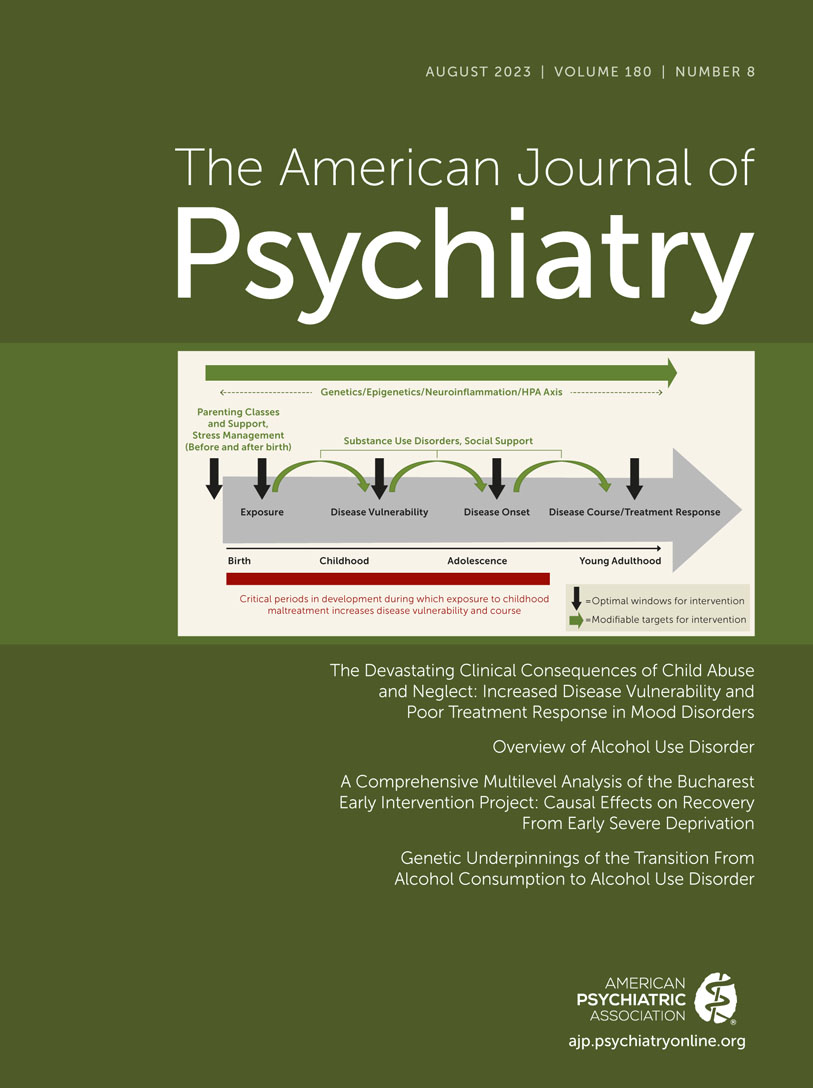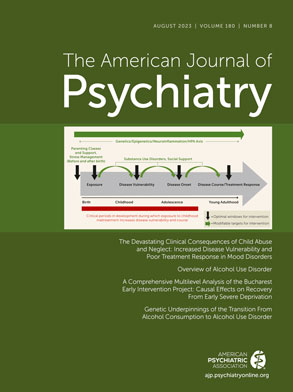In this issue, Kember et al. (
1) report an impressive undertaking to identify genetic contributors to both alcohol consumption and alcohol use disorder (AUD) in the largest study to date, both in terms of sample size and in terms of inclusion of non-European population groups. The authors also capitalize on the unique construction of the Million Veteran Program (MVP), with longitudinal data from alcohol consumption screenings and alcohol use disorder diagnoses in health records, to better refine phenotypes and analyses, something few other studies can accomplish. In these analyses, performed within and across ancestries, they report a notable 24 independent variants (19 loci) associated with alcohol consumption, quantified by Alcohol Use Disorder Identification Test–Consumption (AUDIT-C) scores (
2), and 26 independent variants (21 loci) associated with alcohol use disorder. The authors also perform gene-based associations, conduct mediation analyses, calculate genetic correlations, construct polygenic risk scores, and perform a phenome-wide association study in two external data sets: the Vanderbilt Biobank (BioVU) and the UK Biobank. Through these analyses, they conclude that differences in the associated loci, differences in genetic and phenotypic correlations, and nonmediating genetic variation support a conclusion that alcohol consumption and AUD have distinct underlying genetic architectures. We submit that, considered with other recent publications on the genetics of both alcohol use and disorder, the results presented by Kember et al. highlight the necessity of minimizing trait heterogeneity by reducing the misclassification of individuals who now abstain from alcohol but who have a lifetime history of alcohol use disorder. When trait heterogeneity is minimized, the overall genetic underpinnings of alcohol consumption and use disorder are, in composition and pattern, quite similar.
Given the heavy focus on genetic correlations as an indication of shared versus distinct genetic architectures for alcohol consumption and AUD, we think it prudent to give a brief overview of genetic correlations reported for these traits. Genetic correlations reported from twin studies suggested moderate to high correlations (r
g range, 0.45–0.99) among several alcohol consumption traits and high correlations between alcohol consumption traits and problematic alcohol use (
3,
4). Using cross-trait linkage disequilibrium score regression, reported genetic correlations between alcohol consumption traits and problematic alcohol use or alcohol use disorder have ranged widely (
Table 1). In one of the earliest studies of individuals of European ancestry, the reported genetic correlation between AUDIT score and alcohol use disorder was negligible (r
g=0.08) (
5). Notice that several of the comparisons in
Table 1 used the same cohorts or used the same trait (e.g., AUDIT-C score) in different cohorts, illustrating that seemingly innocuous differences in trait derivation and sample makeup can lead to large differences in estimated genetic correlations. Importantly, the study by Kember et al. compares alcohol consumption and alcohol use disorder measured in the same individuals, which eliminates biases in the estimated genetic correlations from sample selection and comorbid illness. When the authors focus analyses on those who report current drinking and exclude those who abstain from alcohol, 15% of whom have a lifetime history of alcohol use disorder, the genetic correlation between alcohol consumption and alcohol use disorder increases (r
g=0.86–1), and the genetic correlations for individuals of African ancestry are very high (r
g=0.98–1). These findings highlight that the genetic architecture of alcohol consumption and alcohol use disorder is primarily shared.
Several previous studies have reported seemingly divergent patterns of genetic correlation between consumption and use disorder when compared with non-alcohol-related traits. The AUDIT-C was reported to have puzzling positive genetic associations with variables related to socioeconomic status (e.g., educational attainment) and some health outcomes (e.g., HDL cholesterol levels), and negative associations with other health outcomes (e.g., obesity, triglyceride levels) and some forms of psychopathology (e.g., major depression diagnosis, attention deficit hyperactivity disorder) (
5,
6,
11,
14). Opposite patterns of correlation were observed for AUDIT-P (problem items) score or alcohol use disorder (
6,
11). Explanations for these divergent patterns have included true biological differences, confounding by selection bias, genetic heterogeneity, and measurement error. Kember and colleagues again help clarify most of these discrepancies among genetic correlations between alcohol consumption and use disorder and other traits. When the authors examined only those who report consuming alcohol and excluded those who abstain, fewer differences in the genetic correlation patterns for consumption and alcohol use disorder were still evident. Most were different in magnitude, not direction of effect, as reported in Table S16 in the online supplement for the Kember et al. article, and visualized in Figure 2C.
We are at the crux of a revolution in which increasingly data-driven approaches are used to increase phenotypic precision and mitigate biases in genetic analyses of an inherently heterogeneous behavior and disease (
18–
20). With recent evidence that Black and Hispanic veterans from the MVP data set were more likely to have an AUD diagnosis than White veterans, despite similar AUDIT-C scores (
21), this revolution is needed not only to improve our statistical power in genetic association studies, but also to mitigate racial and ethnic bias in diagnosis. We applaud Kember and colleagues for engaging with this revolution by examining different ancestral groups and exploring variations in the trait definitions under study, namely, by modifying the AUD case threshold and excluding those who abstain from alcohol (those with an AUDIT-C score >0), who were previously shown to affect genetic associations (
1,
20). In excluding those who abstain, the authors only “lost” one to two genome-wide significant loci, despite losing almost a quarter of their original sample, suggesting greater power from higher phenotypic precision and reduced misclassification. Kember et al. also observed an increase in the SNP heritability of both AUDIT-C score and AUD diagnosis, further demonstrating the positive impact of reducing bias and improving phenotypic precision in understanding the genetic architecture both of consumption and of AUD (
18,
20).
As with all behavior and neuropsychiatric studies, we are at the mercy of phenotype definitions that boil into a single scale (AUDIT scores) or code (diagnoses) a lifetime of intersecting factors: genetic, social, environmental, and institutional. This heterogeneity of individual experience means that we simply cannot make the mistake of assuming that individuals who share a diagnosis are homogeneous in trait presentation or genetics. This may seem a pessimistic view, but on the contrary, the underlying variation is ripe for interesting studies in which geneticists, epidemiologists, and medical professionals can work together. By using refined phenotype definitions and careful studies, we can find meaningful associations to translate into clinical knowledge and therapeutics. For example, are there methods to mitigate bias in diagnoses of AUD, especially in individuals with moderate to high AUDIT-C scores? Or are there social and genetic factors distinctive to individuals with similarly moderate consumption but disparate AUD diagnoses? As we work to answer these questions, we posit that, in the effort to understand the genetic etiology of alcohol consumption and alcohol use disorder, there is more in common than there is different. We look forward to other creative work from this group and others to move the field further along the path to understanding alcohol consumption and treating problematic alcohol use and alcohol use disorder.

